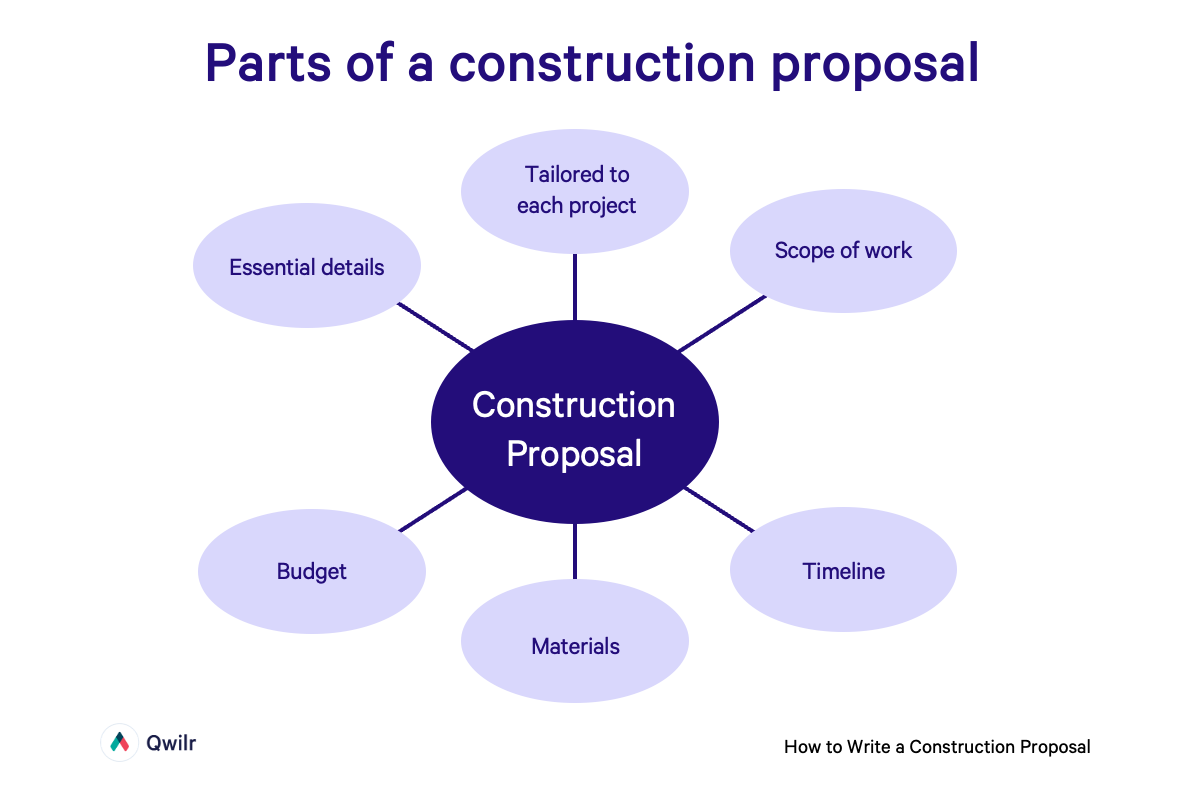Construction proposals are the backbone of every construction business. They're where projects start: they’re the star of the show when it comes to selling and marketing your business, and they can clearly demonstrate your company’s capabilities and skills through compelling visuals of past projects and realistic renderings of potential new work.
A well-written construction proposal is crucial because it sets the tone for your relationship with a potential client, protects you (and the client), and ratifies all the construction project details.
How do you write a construction proposal that wins you business, mitigates risks, and leaves a lasting impression on your clients? And how do you make writing this proposal as quick and as painless as possible so you can get down to doing what you do best? Building, of course!
More of a visual learner? Watch our video on how to write a bid proposal with a walkthrough of Qwilr's template:
What is a construction proposal?
A construction proposal is a document that outlines the details of a construction project and proposes a plan for its completion. It includes information about the scope of work, budget, timeline, materials, and other essential details. It also serves as a crucial blueprint for blue-collar jobs in the construction industry, guiding workers through the project's requirements and objectives, thereby facilitating their effective execution of the tasks at hand.

It is worth mentioning here that construction proposals and construction bids are frequently different, but a construction bid proposal merges the use and scope of a proposal with that of a bid.
Outside of that situation, although used interchangeably very often, the two terms refer to different documents. A construction bid is a competitive document that outlines the pricing for a specific project. At the same time, a construction proposal is a more comprehensive project management document that includes not only pricing but also details about the proposed work and approach.
A construction proposal should be tailored to each individual project and communicate the value proposition of your business. It serves as an initial agreement between you and your client but not as a document you use to compete against other contractors or construction management companies (as in the case of a construction bid.)
Steps to write a construction proposal: Key elements to include
There is no one way to write a construction proposal, but there are key elements all solid construction proposals should include. More specifically, when writing a construction proposal, make sure to address the following sections:
Executive summary
This section offers a big-picture view of the entire proposal and includes information about your firm, an outline of the prospect’s goals and needs, and, most importantly, it positions your firm as the one to choose for the project.
This is where you need to detail the unique benefits of choosing your firm and the reasons that will motivate your prospective client to close the deal.
This section should be concise and comprehensive, outlining the main points of your proposal in a harmonious, engaging way that piques your client’s attention to keep them reading the rest of your document.
Information you can bring into your executive summary includes:
- A brief overview of your construction firm and its history
- Your experience and expertise in the construction industry
- The client's name, project location, and a summary of the proposed work
- The unique selling points of your business that set you apart from competitors
Keep in mind that you only have about a page or so to capture all of these important details, as busy executives just need the main bullet points to pass along your proposal to their teams or compel someone to keep reading. Think of this section as your elevator pitch, and don’t add a lot of fluff - just the most salient points.
Detailed scope of work and project proposal
This section is where you describe the entire scope of the project and project proposal. It outlines what tasks, deliverables, and outcomes can be expected from your company throughout the project.
Take it as your opportunity to take a deep dive into the details of your offer and how it addresses each of your prospect’s needs in this project. This is the perfect place to begin with a problem statement that identifies and demonstrates your understanding of the project's needs.
As a contractor, you must ensure that this section is as detailed and specific as possible to avoid any discrepancies or misunderstandings with the client. As such, you should include a description of your solution, keeping the focus on what you can do for the potential client. This helps keep your sales proposal relevant and tailored to your potential customer’s needs regardless of the sales methodology you're using.
This section should should include information such as:
- A thorough description of the project, including any drawings, renderings, or blueprints
- An explanation of the customer needs and requirements
- A detailed overview of the solution you propose
- A list of materials and equipment needed for the project
- Any limitations or exclusions to your services (e.g., not responsible for obtaining permits)
Cost estimate
Some construction proposals merge this section with the "Scope of work" one, but there are benefits to keeping them separate. By presenting the cost estimate in its dedicated section, you can highlight how it aligns with the scope of work and benefits the client.
In this section, you should include a line-item breakdown of all costs associated with the project, including labor costs, materials, permits, and other fees. This helps build transparency and trust with your client, so provide detailed and accurate estimates.
While determining a price point for the project and materials could effectively be its own article, there’s a lot of opportunity in this section to demonstrate the monetary value of your services. For example, you can give your prospect a choice between several different project scopes and ideas or even try to upsell by mentioning the prices of optional extras.
If you’re using an online proposal software option like Qwilr, you can easily add optional line items and give your prospect a choice between different project packages in your pricing section. This will allow the client to select the items they want, and the final price will be updated in real-time.
It is essential to outline any payment terms and schedules and clarify any policies or fees related to change orders or delays. This ensures that both parties are on the same page regarding expectations and payments.
Payment schedule and project timeline
This section can work as a stand-alone element of your construction proposal or be merged with the "Cost estimate" or "Scope of work." In either case, the payment and work schedules must be clearly outlined and agreed upon by both parties before the project begins.
The payment schedule should detail how much the client will pay when payments are due and any penalties for late payments. The project schedule should include start and completion dates, as well as workflow mentions, milestones, or checkpoints you agree to have throughout the project.
Terms and conditions
This is a vital section of your construction proposal because it describes the terms and conditions that both parties must agree to for the project to commence. It is essential to include any specific clauses or legal requirements that protect your company, such as a liability waiver or dispute resolution procedures.
For example, you may want to outline your company's insurance coverage and any warranties or guarantees that come with your services. This helps protect both parties in case of unforeseen circumstances or issues during the project.
Likewise, you may also want to specify any special terms or conditions related to your company's policies and procedures, such as environmental regulations, safety protocols, or what happens if the project is delayed for reasons out of your control (e.g., bad weather, supply shortages, and so on.)
Relevant authorities
This should be a relatively short section of your proposal (you can consider it a separate topic or merge it with the "Terms and Conditions" section you’ve already created.) Essentially, this is where you specify any necessary permits, licenses, or certifications needed for the project.
This helps ensure that your company complies with all legal requirements and can proceed with the project without delays or issues.
It is important to clearly state which party will be responsible for obtaining these documents (usually the contractor) and any estimated costs or timelines associated with them.
Warranty
You want your customer to know their project is protected by the high quality of your work, which is why you should include a warranty section in your proposal. This outlines what warranties or guarantees you offer for your services and any applicable limitations or exclusions.
This section helps build trust and confidence in your company's abilities, making it more likely that the client will choose to work with you over competitors who do not offer similar warranties.
It is essential to be specific and transparent about what is covered under the warranty and for how long. If there are any limitations or exclusions to the warranty, make sure to clearly state them as well -- the last thing you want is angry former customers ruining your reputation over misunderstandings and false expectations.
Owner information and acceptance
This is often the last section of a construction proposal, where you provide all the necessary contact information, and your prospect can accept your offer.
In the contact information section, include your company's name, address, phone number, email, and any other relevant contact details (including details for subcontractors or key suppliers you might use.)
You may also want to include a signature line for the client to indicate their acceptance of the proposal. This helps ensure that both parties are in agreement and protected legally in any situation.
Qwilr makes creating this section of your proposal especially easy all you have to do is add an ‘Accept Block’ to your document, and your proposal is ready for the prospect to close the deal.
Tools like Qwilr allow your firm to be agile and produce a full audit trail of the entire interaction so it’s fully compliant with all eSignature laws, which means it’s a legally binding construction contract.

With a PDF or a paper document, the process of getting a proposal signed fully can take days or even weeks. Online documents can be viewed at the prospect’s convenience and can help you get the signatures you need to close the deal faster.
Social proof
Everyone looks at the reviews before they make a buying decision, and business partners are no different. About 90% of businesses read online reviews and forums before they make a purchasing decision.
Social proof has undeniably become an important part of the buying cycle and decision-making process before making a purchase. As such, it would be a missed opportunity if you don’t include a section that shows off your most significant success stories, past work, and previous achievements.
Include your choice of case studies, testimonials, or awards in this section to create trust with your prospective clients and prove that you can produce results.
When you write a case study, be sure to outline the previous project’s unique challenges and needs and highlight the steps you took to help the client overcome each. Back this up with numbers, and boom, you’re one step closer to convincing your potential client to sign the proposal.
Example of construction proposal template
Qwilr's construction proposal template was built to make it easy for contractors and construction companies to create professional and comprehensive proposals for potential projects. Alternatively, check out our AI Proposal Generator to create a custom construction proposal in minutes.
The best proposal templates improve both sales efficiency and effectiveness.
This template includes all the necessary elements.

How do you write a construction proposal?
The best way to write a construction proposal is by using a template that covers all the information you need to include and then adjusting it to each project and use case. This saves time, makes you look professional, and ensures you don’t miss any crucial details.
- Summary
- Timeline
- Logistics
- Company Profile
- Construction Job Site & Project Estimate
- Terms and Conditions
This construction project proposal template includes sections and sub-sections for the work scope, plans and permits, expectations, materials, site management, communications, past projects, and a detailed project cost breakdown.
Additionally, the proposal template has a pre-embedded Calendly link so your prospects can book a meeting with you easily. And if you want to, you can very easily add an e-signature field, too, to make it all legally binding.
All you have to do to use this template is grab it, adjust it to your specific business and project, and then send it to your customers (they don't need to have a Qwilr account; they can access the proposal as they would with any regular web page.)
Make your construction proposals easy to write and distribute
Writing a construction proposal shouldn't be a painful, headache-inducing task. On the contrary, it can be an opportunity to showcase your company's strengths and prove why you're the best fit for the project.
Using tools like Qwilr to make your construction business proposal visually appealing and easy to read and including social proof in the form of case studies and testimonials, you can create a winning proposal that sets you apart from the competition. All you have to do is:
- Get the template
- Update it using your information, company logo, project specifications and details
- Send it to your prospect
That's it! And you can repeat the same process over and over again with all of your prospects, to ensure consistency, save yourself time and energy, and deliver an excellent experience for every customer. Ready to get started and want some support? Schedule a demo today and a member of our team can get you set up.
About the author

Marissa Taffer|Founder & President of M. Taffer Consulting
Marissa Taffer is the Founder & President of M. Taffer Consulting. She brings over 15 years of sales and marketing experience across various industries to a broad range of clients.
FAQs
The best format for a construction proposal is a succinct, yet comprehensive overview of what you can provide as a contractor or construction business for your customer. This includes your information, the project overview, the cost breakdown, the payment plan, the project timeline, any terms and conditions, and what warranty you offer.
A proposal for a construction project is a document that outlines the scope of work, costs, timelines, and terms and conditions for a specific construction project. It is used to communicate these details to potential clients and secure their business. A well-written proposal can build trust and credibility with the client, and set the right expectations from the get-go., testimonials, or awards in this section to create trust with your prospective clients and prove that you can produce results. In a case study, be sure to outline the previous project’s unique challenges and needs and highlight the steps you took to help the client overcome each one of them. Back this up with numbers and boom, you’re one step closer to convincing your potential client to sign the proposal.
The best way to write a construction proposal is by using a template that covers all the information you need to include and then adjusting it to each project and use case. This saves time, makes you look professional, and ensures you don’t miss any crucial details.


